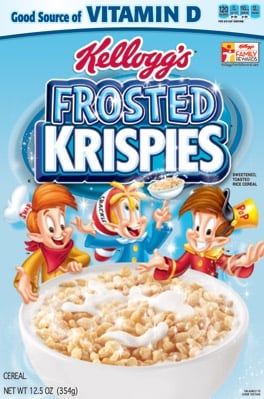Kellogg, General Mills, Weetabix and others have a great number of fortified kids’ cereals on shelf.
But on-pack nutrient content claims like ‘good source of’ or ‘high in’ feature more heavily than explicit health claims linking ingredients to diseases and health conditions.

Kellogg, General Mills and Weetabix
Kellogg’s cereal portfolio targeting children is littered with nutrient content claims. A ‘good source of vitamin D’ features heavily across its portfolio – on Rice Krispies, Fruit Loops and Honey Smacks. A ‘good source of fiber’ also features on Corn Pops and Frosted Mini Wheats.
The Kellogg Company faced class action lawsuits totting up over $10m on its use of a structure/function claim on its Frosted Mini-Wheats and Rice Krispies, both back in 2010.
The company claimed that consumption of its Frosted Mini-Wheats was ‘clinically shown to improve children’s attentiveness by nearly 20%’ and that
Rice Krispies ‘now helps support your child’s immunity’.
General Mills does however continue to make its health claim on its use of ‘cholesterol lowering’ oats in Cheerios. It can make this claim because of the FDA approved claim on soluble fiber from certain foods linked to the risk of coronary heart disease (CHD).
However, General Mills too has been hit by enforcement. In 2010 it received an FDA warning letter because its claims stated ‘you can lower your cholesterol by 4% in 6 weeks’.
Weetabix previously made a 'slow release energy' claim on its flagship product due to the iron content in the cereal. But it has since removed this and changed to a strap 'fuel for your day' after a pounding last year from the UK Advertising Standards Agency (ASA). The agency said the claim was misleading because it was only relevant when consumed with milk.
‘Market leaders don’t need health claims’
Commenting on the market trends, food law attorney Jonathan Emord said that ironically market leaders are comfortable with not having any health claims on pack. “Market leaders have the dynamic of being in a market leader position. They don’t need health claims,” he said.
He said it is the “little guys” and mid-sized firms that could benefit from the ability to make health claims without fear. The marketplace would be more diverse with new entrants and healthier products if so, he added.
Emord said a preference for nutrient content claims was prompted by a fear factor and economies. This shy away from using qualified health claims on pack, he said, is to avoid being at odds with primary regulators. He added that the consumer marketplace also suits nutrient content claims because the mere reference of a popular ingredient is sufficient to call to mind health notions.
Market leaders are taking advantage of this, he said. “Using clever phraseology that can tie into health information is the choice.”
No shift away, just caution
Martin J. Hahn, partner in the Food and Agriculture Group at Hogan Lovells, disagreed that companies are shifting away from qualified claims. He said there is just caution and consideration when using them.
Definitions
Qualified health claim: Approved by the FDA or EFSA, makes a claim that links to a disease or health-related condition
Nutrient content claim (US)/ nutrition claim (EU): Approved by EFSA and the FDA, outlines ingredient content and amount
Structure/function claim (US): Does not need FDA approval, describe role and benefit of nutrient
“New emphasis on litigation is causing companies to look more critically at health and nutrient content claims to confirm they comply with all technical requirements.”
Hahn said it is increased scrutiny from state and federal regulators as well as class action lawyers prompting cereal makers to take up a more conservative position.
“I also have heard anecdotal reports the health claims are too complicated and clunky and considered ineffective at strong communications while a nutrient content claim or a structure/function claim can be tighter, shorter, and more powerful,” Hahn said.
